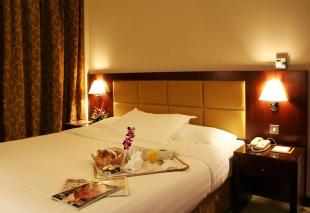

Top 50 ways to 'green' your hotel and reduce costs

Energy costs and world energy consumption continue to increase. Now is the time for hotel management to work with facility engineers, maintenance staff and others to explore innovative solutions and green practices to help improve guest comfort and manage operating costs, says Luc Onockx, regional head of controls contracting and turnkey solutions business, Trane.
Onockx, who has more than 15 years of HVAC industry experience with specific focus on energy performance contracting, says that a smart approach is to implement green practices incrementally by exploring what can be done in the short-term (zero to three years), near-term (three to eight years) and long-term (more than eight years).
By implementing some of these tips, hotels can easily save between 10% and 25% annually on their energy bills, according to Onockx.
Even small changes can result in significant budget savings that are directly reflected in the bottom line. These savings may be used to fund more significant investments in energy and related systems.
Here are 50 ways – near-term, mid-term and longer-term ─ to green your hotel, improve guest comfort and reduce operating costs:
Short-term payback plan: (zero-to-three years)
Building envelope
1. Find and fix leaks (doors and windows)
Lighting
2. Install occupancy sensors
3. Retrofit existing lighting fixtures (T12 – T8 to T5)
Motors
4. Properly size to the load for optimum efficiency
5. Check alignment
6. Check for under/over voltage conditions
Pumps
7. Operate pumping near best efficiency point
8. Modify pumping to minimise throttling
9. Adopt to wide load variation with variable speed drives
10. Use booster pumps for small loads requiring higher pressures
11. Repair seals and packing to minimise flows and reduce pump power requirements
Controls/Automation
12. Check schedules, set-point, and setbacks
13. Confirm heating, ventilation, air conditioning (HVAC)/refrigeration control strategies are correct /operational
14. Check/inspect/repair systems for proper operation (fans, dampers, belts, filters, variable air volume boxes, etc.)
15. Use free-cooling when using chilled water system in cold weather or night time
Steam
16. Fix steam and condensate leaks
17. Inspect steam traps regularly and repair malfunctioning traps promptly
Boilers
18. Preheat combustion air with waste heat
19. Use variable speed drives on larger boiler combustion air fans with variable flows
20. Inspect and clean burners and nozzles
21. Close burner air and/or stack dampers when off
22. Automate boiler blow-down and recover blow-down heat
23. Use boiler blow-down to help warm the back-up boiler
24. Inspect door gaskets
25. Optimise boiler water treatment
26. Add an economizer to preheat boiler feed-water using exhaust heat; recycle steam condensate and isolate boilers when not in operation
Water and sewer
27. Recycle water, especially if sewer costs are based on water consumption
28. Use the lowest possible hot water temperature
29. Fix water leaks
30. Use water restrictions on faucets, showers, and/or install self-closing type faucets in restrooms
31. Verify water meter readings
Click through to next page for near-term payback tips...
Near-Term Payback Plan (three-to-eight years)
After reviewing short-term options, the next step is to undertake a more rigorous assessment. The following list details investments or changes that still have attractive payback, but may take more time to investigate and execute.
Systems change out
32. Evaluate chilled water system to specifically consider replacement of chiller(s) with more efficient models. Using the Trane Chiller Plant Analyzer is a great way to start.
33. Consider gas-powered refrigeration systems to minimise electrical demand charges
34. Assess new HVAC system
35. Replace boilers (higher efficiency, condensing, modular, etc.)
36. Consider installing: thermal storage/heat recovery systems
Operational strategies
37. Determine and implement optimum building automation/control strategies
38. Consider different utility purchasing options, rate analysis, and/or buying utilities on the commodity market
39. Ensure high efficiency motors are matched to size/loads
40. Optimize compressed-air systems for maximum efficiency through leak analysis and end-user requirements assessment
41. Study part-load characteristic and cycling costs to determine the most efficient mode for operating multiple boilers
42. Consider more efficient options (don’t use the main heating boiler) for domestic hot water during the cooling season
Click through to next page for a longer-term payback plan...
Longer-term payback plan (more than eight years)
The following improvements can provide a significant efficiency upgrades in a facility:
Systems change out
43. Consider a new chilled water system
44. Implement major HVAC system replacements
45. Install new or upgrade controls/facility automation system
46. Install a geothermal heat pump system
Operational strategies
47. Assess and verify reliability/availability of utilities (on-site generation)
48. Study facility envelope (windows, doors, and roof) and make necessary improvements
Renewable energy solutions
49. Study the benefits of adding some renewable technologies such as: solar, wind, biomass
Ongoing Maintenance
50. Engage in proactive maintenance for sustained performance.
Making improvements of any kind to a facility can help hotel operators achieve better performance and have a positive effect on guest comfort, staff productivity and budgetary resources. Specific results and cost savings will be unique to each hotel.
While higher initial costs may be incurred with ‘green’ design, upgrades and operational improvements often create cost savings that exceed the original investment.
Ultimately, a green facility creates a healthier and more resource-efficient model of construction, renovation, operation and maintenance; while providing a more enjoyable and productive environment for guests and staff. This is good for customers; good for your business, and good environmental stewardship.
About the author: Luc Onockx
Luc Onockx is responsible for the controls contracting and turnkey solutions business for Trane in the EMEIA region. He has more than 15 years of HVAC industry experience with specific focus on energy performance contracting. Luc earned a master’s degree in mechanical and electrical engineering from the Free University of Brussels and worked with Honeywell prior to joining Trane.